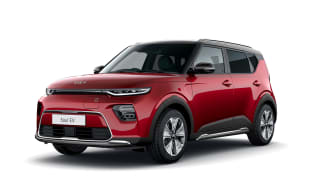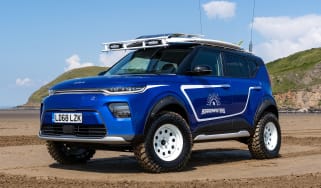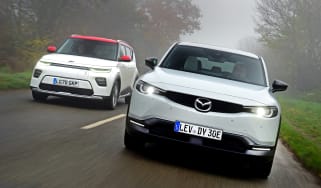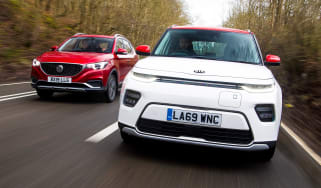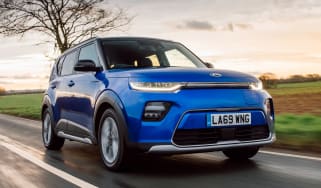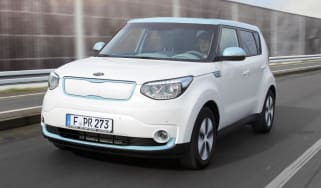Kia Soul EV review
The Kia Soul EV is more interesting than the Niro EV, with its bold styling, generous kit levels and impressive range

The Kia Soul EV is the black sheep of the Kia family and, in our eyes, one of the more underrated electric cars on sale. The new entry-level Urban model in particular, because it serves as a fairly practical and surprisingly spacious alternative to zero-emissions city cars and superminis that cost similar money.
The pricier Explore model on the other hand, faces off against electric SUVs with more boot space and better technology. But few are as interesting to look at as the Soul EV, and Kia’s boxy baby SUV is still comfortable, easy to drive in town and comes with plenty of kit as standard.
About the Kia Soul EV
The original Kia Soul EV was one of the first electric cars we saw in the UK, but sales were hampered by a high price, limited range, a charging network in its infancy and general apathy towards EVs. But 2014 was ever such a long time ago.
Clearly Kia was confident in the quirky electric SUV’s potential, as 2020 saw the arrival of the second generation Soul EV – based on the running gear of the South Korean brand’s popular e-Niro that had launched just one year earlier. Petrol and diesel-powered versions of the Soul were also given the boot from UK showrooms. The all-electric compact SUV was then given some minor tweaks in 2021, before a much more significant round of updates were implemented in early 2023.
Used - available now

2022 MINI
Countryman
15,110 milesManualPetrol1.5L
Cash £18,100
2023 Mercedes
CLA Shooting Brake
21,622 milesAutomaticPetrol1.3L
Cash £23,200
2022 BMW
3 Series
76,002 milesAutomaticPetrol2.0L
Cash £16,697
2022 Vauxhall
Crossland
18,308 milesManualDiesel1.5L
Cash £13,797At launch the Soul was available with just one battery and in one lavishly equipped trim level initially called First Edition, then Maxx. Now though, buyers have a choice of two models which have different batteries, power outputs and standard equipment.
The new, entry-level Urban model uses a 39.2kWh battery to power a single 134bhp electric motor, and offers a maximum range of up to 171 miles – or more than 250 miles if you stick to driving in town, according to Kia. Standard kit on the Urban includes 17-inch alloy wheels, LED headlights, a reversing camera, a seven-inch driver’s display and a new, smaller eight-inch central touchscreen with Android Auto and Apple CarPlay smartphone connectivity. There are plenty of safety systems onboard too, including forward collision assist and driver attention warning.
The Explore version essentially replaced the old Maxx specification of the Soul EV. So it uses the same 64kWh battery and 201bhp electric motor, which boosts the car’s range up to 280 miles. Inside is a larger 10.25-inch touchscreen, an auto-dimming rear-view mirror, rear parking sensors, heated leather front seats and steering wheel, plus roof rails.
At the time of writing, the Soul EV Urban starts from around £33,000, while the Soul EV Explore comes in at over £39,000. Both price tags are somewhat problematic, because the entry-level model costs about the same as long range versions of the MG ZS EV and MG4 – both winners of our Affordable Electric Car of the Year award, and they can go further on a charge, too. It’s also dangerously close in price to the base Hyundai Kona Electric, which also has a longer range and is simply more classy than the Soul.
Meanwhile, the Soul EV Explore must entice buyers away from its sharper-looking cousins, the Kia Niro EV and Hyundai Kona Electric, other electric crossovers like Peugeot e-2008, Vauxhall Mokka Electric and Smart #1, plus base versions of much larger, much snazzier family SUVs such as the Nissan Ariya, Skoda Enyaq iV and Volkswagen ID.4.
Electric motor, drive and performance
Some electric cars lose momentum after 30mph, but that’s simply not the case in the Soul. It feels quick and punchy, even at motorway speeds, which allows you to merge with traffic with ease.
Regenerative braking handles the task of bringing the Soul to a halt, and you can adjust the rate of deceleration using the paddles mounted behind the steering wheel. With practice, you’ll become accustomed to driving without the brake pedal.
There are four driving modes: Normal, Sport, Eco and Eco+. The latter sticks the Soul into maximum efficiency mode, to the extent that power is reduced and the air-conditioning is switched off. It’s a somewhat tortuous experience, but it could come in handy if you’re down to your last few miles.
The Soul is a thoroughly pleasant car to drive. The steering is light, but not overly so. There’s a reasonable amount of body roll, but it’s kept in check. And the ride quality isn’t overly firm, which isn’t always a given in a heavy electric car. We did notice a bit of wind noise creeping into the cabin at high speeds, and you hear the whir of the electric motor under hard acceleration, but otherwise the Soul is a pretty relaxing car to drive.
0-62mph acceleration and top speed
The Soul uses a single electric motor to drive its front wheels, though the power output depends on the model you go for. The Urban version produces 134bhp and 395Nm of torque, while the Explore offers a beefier 201bhp but the same amount of torque.
It might take the Urban 9.9 seconds to go from 0-62mph, but the instant torque from the electric motor makes it feel deceptively nippy, especially when you floor it at low speeds, which can cause the skinny front tyres to scrabble for grip. Top speed in this version stands at 97mph.
The Explore manages to complete the same benchmark sprint in just 7.9 seconds, and will reach a top speed of 104mph if you’re determined to lose your driving licence. Acceleration is still not hot hatch quick, but it’s still got plenty of oomph for everyday driving.
Range, charging and running costs
The Mk2 Soul EV has been fitted with a 64kWh battery since it launched back in 2019, but is now available with either a 39.2kWh battery in the Urban model or the 64kWh unit if you spring for the Explore version.
The Soul EV Urban has an official range of up to 171 miles, which is more than the Mazda MX-30 will go before it runs out of juice, but the cheaper, entry-level versions of the MG4 and MG ZS EV will go further still. Nonetheless, during our test drive of the Urban we were able to achieve around 4.2 miles per kWh; enough for a real-world range of just over 163 miles.
Kia also claims the Urban model will do 252 miles between charging sessions if you just drive in town. We expect closer to 200 miles of city driving is more achievable, so long as you’re gentle with the throttle, and use the strongest regenerative braking settings.
Meanwhile, the Soul EV Explore gets a much more impressive 280-mile range. We used a Soul EV with the same powertrain for our twin test against the Mazda MX-30, making no attempts to maximise efficiency and testing them both in cold temperatures which tends to eat up the range in EVs. Despite the conditions, the Kia easily recorded 3.9 miles per kWh, resulting in a real-world range of 253 miles.
The Soul EV’s charging port is located in the car’s nose. Plug either model into the 100kW+ rapid chargers that are becoming fairly common in the UK, a 10 to 80 per cent top-up thanks less than 50 minutes – not lightning fast, but you can still add a decent amount of range in the time it takes for a mid-road trip pit-stop.
Fully recharging the Soul EV Urban’s 39.2kWh battery using a typical 7.4kW home wallbox will take roughly six hours, or about 10 hours with the Explore model and its much larger powerpack.
Like all electric cars, the Soul EV is exempt from road tax (VED) and the London Congestion Charge until 2025, and it currently attracts rock-bottom Benefit-in-Kind (BiK) tax rates, which is great for company car drivers.
Insurance groups
The Soul EV Urban sits in insurance group 26, while the more expensive Explore model lands in group 31. That means getting cover could be expensive, though the MG ZS EV and Kia Niro EV do attract similar insurance ratings.
Check if your car needs an MoT and view its complete history with our MoT History Checker...
Depreciation
According to our latest expert data, the Soul EV should retain between 45 and 47 per cent of its value after three years and 36,000 miles. The Soul EV Urban is expected to retain more of its list price, but only just, and the Niro EV is expected to perform a lot better on the secondhand market, retaining up to 59 per cent of its list price after the same 36-month ownership period.
To get an accurate valuation on a specific model check out our free car valuation tool...
Interior, design and technology
The second generation Soul EV is arguably less dramatic than its predecessor, but the pseudo-SUV’s unique boxy silhouette remains the same. The incredibly slim LED headlights are another distinguishing feature on the Soul, along with the off-set charging port housed in the front bumper.
The Soul did get a couple of minor styling tweaks as part of its recent facelift, namely the new Kia badge integrated into the section linking the headlights and on the tailgate.
When you consider the Soul has to sit alongside the Niro EV, flashy EV6 and seven-seat EV9 in Kia’s showrooms, its ability to stand out next to what are already some of the most distinctive and futuristic-looking electric cars on sale is arguably impressive.
Meanwhile, the Soul’s cabin is a more simplistic and functional affair than those in its stablemates. There’s no fiddly touch-sensitive climate controls, just chunky buttons and dials that are easy to use. The high driving position favoured by SUV drivers is also present and correct and overall build quality is solid.
That said, it’s not the plushest interior and the piano black trim will attract lots of dust and fingerprints. Some of the other plastics feel a little low-rent too, but the key touch points leave a good impression.
Standard kit on the base Urban model includes 17-inch alloy wheels, LED headlights, a reversing camera, fabric upholstery, air conditioning, lots of safety kit, a seven-inch instrument panel and an eight-inch touchscreen with Android Auto and Apple CarPlay connectivity.
Explore specification builds on this with leather upholstery, heated front seats and steering wheel, tinted windows, more safety tech and rear parking sensors, plus a 10.25-inch touchscreen with sat-nav built-in.
Sat-nav, stereo and infotainment
The new eight-inch touchscreen is a relatively low-res display compared to the 10.25-unit that’s been fitted in the Mk2 Soul since it launched (pictured above). In past tests we’ve found the larger display is sharp and easy to read, and Kia’s infotainment system is intuitive and packed with features. There are big physical shortcut buttons below the screen as well, and as we mentioned Apple CarPlay and Android Auto come standard with both setups, so you can use your favourite music and navigation apps.
Practicality, comfort and boot space
The Mk2 Soul EV is larger than its predecessor, but it’s smaller than the Niro EV it sits next to in Kia’s electric car lineup. It’s less practical than the Niro EV too, but the Soul’s big, boxy body means that it's surprisingly spacious considering its relatively small footprint.
There’s plenty of space from your odds and ends too, while the slightly raised ride height and large windows mean visibility is great. The Soul’s flat tailgate also helps when you’re parking, as does the standard-fit reversing camera.
Dimensions and size
The Kia Soul EV is 4,195mm long, 1,800mm wide and 1,605mm tall. It’s actually closer in size to the Ford Puma than the Kia Niro, with Ford’s smallest SUV measuring 4,207mm in length, 1,805mm wide and standing at 1,537mm tall.
Leg room, head room & passenger space
There’s plenty of legroom and headroom throughout the cabin, although the middle seat of the rear bench is best suited to children or for occasional use. The floor in the back isn’t completely flat like you’ll find in some other EVs, but the small hump doesn’t eat up too much foot space. Overall, the fact that the Soul can seat four fully grown adults in comfort is impressive for a car of this size.
Boot space
The Soul EV has a 315-litre boot, which is about 160 litres down on a Niro EV and MG ZS EV’s luggage capacity, and only slightly more than you get in a Vauxhall Corsa or Peugeot 208. We think it’s enough space for daily tasks and the weekly family shop, and only longer journeys will push the limits of the Soul EV’s load bay. At least the boot’s square shape makes stacking suitcases easy.
With the 60:40-split rear seat folded down, the cargo space expands to 1,339 litres, which surprisingly is more than the ZS EV offers. Plus every model gets a height adjustable boot floor, and in the higher position you get lots of hidden storage space that’s ideal for keeping your charging cables out of sight. There’s no frunk or ‘froot’ under the bonnet though, and the Soul EV isn’t rated for towing.
Reliability and safety
While the original Soul EV was put through Euro NCAP’s battery of crash tests, and received a four out of five-star rating for its performance, the second-gen model has yet to be tested by the industry body.
It does however come with an extensive list of safety features, with all Soul EVs featuring a driver attention warning, forward collision-avoidance assist, lane keep assist, high beam assist and adaptive cruise control. The range-topping Explore models goes slightly further, adding rear-cross traffic avoidance assist and blind spot collision avoidance assist.
The Soul EV was one of 14 Kia models to make it onto our list of the best cars to own, which is based on owners’ feedback from the most recent Driver Power customer satisfaction survey. In fact, the Kia Soul finished an impressive 18th out of 75 cars, ahead of both the latest Niro and Sportage. Meanwhile Kia as a brand finished sixth in our best car manufacturer rankings, with strong results across the board.
Warranty
The Soul EV is covered by the same seven-year/100,000-mile warranty enjoyed by the rest of the Kia range.
Servicing
The Soul EV requires a service every year or 10,000 miles, whichever comes sooner. Kia offers a number of different service plans for the Soul EV, with the longest covering three years of scheduled maintenance.







